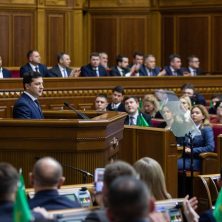Every resident of a village or town has the right to modern medicine and education, accessible and high-quality administrative, communal, social services, good roads, clean and illuminated streets. But people can only influence the quality of these services when those responsible for providing them are near.
The closest to the people is the local self-government bodies: village, settlements local councils and their executive committees. Therefore, they must have broad powers and sufficient resources to be able to address and be responsible for all local issues. For this purpose, decentralization is taking place in Ukraine – the transfer of powers and finances from the state authorities as close as possible to the people – to local self-government bodies.
As part of the Percentage of Truth project, VoxCheck and Ukrainian Radio have figured out what decentralization reform has entailed and why it has started, what changes we can already see, and what lies ahead. And of course, we refuted the most popular manipulations about the reform and prepared a list of official sources on the subject.
Disclaimer: This material was prepared with the support of the American people through the USAID Media Program in Ukraine, implemented by the international organization Internews. Content is the sole responsibility of VoxUkraine and does not necessarily reflect the views of USAID, the US Government, or Internews.

Why does decentralization affect everyone?
The reform is needed so that citizens can choose a reputable local authority that will have more opportunities to develop territories and create educational, medical, transport, housing and communal infrastructure.
However, this does not mean that the state ommits responsibility for these areas. But everyone will work: the law will set education standards, the government will develop programs, and the community will calculate the money and decide where the school should be and how best it will be: one big school for five villages or one small for each village.
The interests of the people who reside in the amalgamated hromada (community) are represented by elected chairmen, deputies, and executive bodies of the community council. In the settlements that are part of the ATC, the right of residents to local self-government and the provision of services is provided by their chosen starosta.
Decentralization will also accelerate health, education, social services, energy efficiency and more.
What did decentralization reform entail?
The state policy of Ukraine in the field of local self-government is based on the interests of residents of territorial hromadas (communities) and provides for decentralization of power – that is, the transfer from the executive authorities to local self-government bodies of a large part of powers, resources and responsibilities. This policy is based on the provisions of the European Charter of Local Self-Government and the world’s best standards of public relations in this area.
The legal basis for a radical change in the system of government and its territorial base at all levels began to emerge in 2014.
In April 2014, the Government approved a key concept document – Concept of Reforming Local Self-Government and Territorial Structure of Power. After that, the Action Plan for its implementation was approved, which initiated the reform. To implement the provisions of the Concept and the objectives of the Action Plan, it was necessary first to amend the Constitution of Ukraine, as well as to formulate a package of new legislation.
Amendments to the Constitution were primarily intended to address the formation of executive bodies of regional and district councils, the reorganization of local state administrations into control-supervisory bodies, and to give a clear definition of the administrative-territorial unit – the community.
Through the efforts of domestic specialists, practitioners, scientists, experts, the draft amendments to the Constitution were developed and submitted for wide public discussion. The proposed changes were supported by the public and highly appreciated by the Venice Commission.
Unfortunately, political circumstances did not allow the Verkhovna Rada of Ukraine to accept amendments to the Constitution on decentralization submitted by the President of Ukraine.
Therefore, since 2014, the Government has initiated reform within the framework of then effective Constitution.
Decentralization, started in 2014, is perhaps the most important of the structural reforms. Prior to the reform, there were four administrative levels in Ukraine: village / city – district or city – region (oblast) – country. Many villages were too small to provide high quality public services to their residents. Decentralization reform involves the creation of Amalgamated United Territorial Communities (ATC or OTG in Ukrainian) that will receive significant budgets for these needs. The target minimum population of ATCs is 10,000 people.
In order to encourage voluntary amalgamation of community the newly created ATC were provided with fiscal incentives – 60% of the personal income tax and 10% of the income tax remain in the community, and they also receive subsidies and subventions for infrastructure development from the state budget. ATC have the right to determine independently the rates of real estate and land taxes within the established limits. At the same time, the responsibility of local authorities for the daily life of citizens has increased significantly, as local authorities distribute medical and educational subventions, infrastructure funds and so on.
Important to the success of decentralization was the government’s decision to allow ATC to receive state land around them into their communal property. These lands can be a significant source of income for communities. Sometimes ATC has to sue the State Geo Cadastre to obtain these lands.
According to the logic of the reform, at some stage it will be necessary to amend the Constitution in order to consolidate new realities and the distribution of power between the center and the regions. If Parliament begins to work on such amendments to the Constitution, it can take this opportunity to deprive the President of the ability to interfere with government policy.
What changes have already taking place and what are in the future?
Meanwhile, the major package of new legislation has been developed and become effective, the priority legislative initiatives of which legislation are currently being implemented.
This refers to:
- Laws on Amendments to the Budget and Tax Codes of Ukraine. These changes have led to financial decentralization.
- The Law on“On Voluntary Amalgamation of Territorial Communities”. Enabled to form a capable basic level of local self-government. From 2015 to 2018, 878 Amalgamated Terriotorial Communities (ATC) were formed in Ukraine. Those ATCs are composed of about 4000 former local councils. 9 million people reside in the ATCs. Such rates of inter-municipal consolidation regarded very high by international experts.
The law also introduced the institute of starosta of ATC who represent the interests of rural residents in the community council. There are already 786 startosta working in ATC villages, with almost 1.7 thousand are acting starosta.
In 2018, the amalgamated communities received in their communal property almost 1.5 million hectares of agricultural land outside settlements.
- The Law “On Cooperation of Territorial Communities” . It established the mechanism of dealing with common problems faced by communities: waste management and recycling, development of shared infrastructure, etc As of the end of 2018 – 325 cooperation agreements are already being implemented. 925 communities have taken advantage of that mechanism.
- Law “On Fundamental Principles of the State Regional Policy”. The government support for development of regional and community infrastructure has increased 39 times since the reform, from $ 0.5 billion in 2014 to $ 19.37 billion in 2018. Due to this support, more than 10,000 projects were implemented in the regions and communities in 2015-2018.
- A package of laws pertaining to the enhancement of powers of local self-government bodies and the optimization of administrative services provision. It allowed delegating powers to provide administrative services to local self-government bodies of respective level: individuals registration at the place of residence, issuance of national identity documents, state registration of legal entities and individuals, entrepreneurs, associations of citizens, civil registration, registration of proprietary rights, dealing with land issues, etc.
The new legislative framework significantly strengthened the motivation to inter-municipal consolidation in the country, created appropriate conditions and mechanisms in terms of legal framework for the establishment of capable territorial communities in villages, towns, and cities consolidating their efforts with the aim of resolving pressing problems. Also, the new model of financial support to local budgets has proved to be effective, which budgets obtained autonomy to certain extent and independence from the central budget.
Decentralization has two important policy implications. First, it enables the emergence and organic development of local political leaders. In Ukraine, the traditional path to politics lies either through joining a party in which the leader acts as an “locomotive” or through bribery of voters in a particular district – directly or through gifts or certain benefits to the community. Due to decentralization, local politicians have been motivated to provide high-quality services to their communities to move to a higher level.
Second, expanding the influence of local authorities on most aspects of daily life will deprive voters of blaming others for problems, except than their elected officials. This should promote more responsible voting.
Of course, these changes do not happen in one day. However, the first steps are in the right direction and the reform must continue.
On January 23, 2019, the Cabinet of Ministers of Ukraine initiated the transition to a new stage of decentralization reform, which envisages consolidation of the already achieved successes and formation of able communities, change of territorial structure at the level of districts and communities, clear separation of powers and functions of control of different levels of government, as well as development of forms of local governance democracy.
The Government has identified support for decentralization reform in Ukraine as one of its priorities, which will promote the development of local self-government and economic development of the country as a whole. It is expected that 2019 will be a key one in shaping the basic level of local self-government: by the end of the year, most existing small local councils may unite, and thus become able to assume most of their powers, use resources appropriately and be responsible for their actions or omissions before the people and the state. This will provide a sound basis for the next steps of local government reform, and will accelerate reforms in health care, education, culture, social services, energy efficiency and other sectors.
The next step is to amend the Constitution on decentralization, which is needed to further advance the reform and complete it.
A number of important laws must also be enacted:
- “On Fundamental Principles of Administrative and Territorial Structure of Ukraine” Within the framework of the effective Constitution, it determines the fundamental principles on which the administrative and territorial structure of Ukraine, types of settlements, the system of administrative-territorial entities, powers of the governmental authorities and local self-government bodies in terms of the administrative and territorial structure, procedure for the formation, liquidation, establishment and changing the boundaries of administrative-territorial entities and settlements, maintenance of the State Register of Administrative-Territorial Entities and Settlements of Ukraine should be based.
- On Amendments to the Law “On Regulation of Urban Planning Activity”. It will remove the gaps in terms of regulation of the town planning and make any unauthorized use and allocation of land impossible
- “On Service in the Bodies of Local Self-Government” (new redaction). It will ensure equal access to service in local self-government bodies and enhance the prestige of service in them, as well as enhance the motivation of local officials in terms of development of communities and individual development of the officials.
- Regarding government supervision of the legality of resolutions passed by the bodies of local self-government.
- On local referendum
- Updating of laws on local elections, on local government, on local state administrations, etc.
How politicians manipulates about decentralization?
Manipulation
“In 4 years, local budget revenues have grown from 69 billion to 231 billion, which is a forecast for the end of this year. How can this be objected to? How can not appreciate that the president and the government gave away the money? ”
Petro Poroshenko on growth of own revenues of local budgets, 12/11/18 (2: 40-3: 15)
Manipulation
“The powers have already been given. The money (in local budgets – ed.) was 70 billion, today it is 230 billion. ”
Volodymyr Groysman on local budgetsLocal Budgets, 14/11/18 (1: 46-1: 51)
In nominal terms, local budgets (excluding intergovernmental transfers as of January 1) increased from UAH 105 billion in 2014 to UAH 229 billion in 2017 (forecast for the end of 2018 – UAH 242 billion). However, there was significant inflation in the period 2015-2017 – a cumulative 83%, so even without decentralization, nominal growth was expected.
The manipulation is that the speaker uses nominal data, whereas the transfer of funds to places is indicated by the change in the share of local budgets in the consolidated budget. In 2013 , local budgets (including intergovernmental transfers) were UAH 221 billion or 49.4% of the consolidated budget. The decentralization portal reports that the share of local budgets in 2017 is 51.2%. So, some redistribution has taken place, but not as significant as the speaker points out. At the same time, local governments were given more freedom to dispose of these funds.
False
“Here, probably, with a bottle of cognac, the official sat, a map of the region, drawing these amalgamated territorial communities, without approval, usually it was done this way.”
Oleh Tyagnybok on decentralization, 05/07/2018 (28:45-28:55)
In Ukraine, the methodology of forming capable territorial communities is approved, which defines a clear procedure for the formation of prospective plans for the formation of a ATC. Paragraph 5 stipulates that when drawing up plans, representatives of local self-government bodies, people self-organization bodies and the public of the respective administrative-territorial units should be involved as necessary. And paragraph 11 stipulates that consultations with self-government bodies, public and business are obligatory during:
- determining the list of territorial communities that may be part of a capable territorial community;
- determining the list of territorial communities whose territories are not covered by the accessibility zones of potential administrative centers;
- defining the boundaries of the territories of capable territorial communities.
In addition, fundamental principle of amalgamation – voluntarily amalgamation. That is, an ATC cannot be formed “from above” – those territorial communities that amalgamates the new ATC must voluntarily agree to do so. So the speaker says falsehood.
False
“We are constantly told about the benefits of decentralizing the budget, how much territorial communities have won from this. All this is true for millionaire cities. For small towns, this is a totally pointless thing. On the background of budget decentralization, for them first changed the legislation and some of the taxes, which were given back 2 years ago, took back into the central budget. But with these incomes, they have disproportionate expenses.”
Yevhen Muraev on the consequences of decentralizaton, 04/01/18 (33:30-34:04)
First, since 2015, when decentralization began, local budget revenues increased 1.7 times, with state budget revenues increasing by only 38%.
Of course, budget revenues during this period were influenced by inflation. Therefore, if you look at local income relative to GDP, growth will be much smaller: from14.8% of GDP in 2015 to 17.7% of GDP in 2017 .
Second, total local budget revenues cover their expenditures (Murayev says “they have paid out incomparable expenditures”). Although, of course, there are some small towns where the opposite situation may be. If we take the total amount of local budget revenues for 2017 – that is, together with transfers from the state budget – it amounts to UAH 502 billion . Expenditures were UAH 496 billion.
Third, if you look at local budgets in the context of ATC or regional centers, their own budgets are also growing.
As for the transfer of some taxes from the local to the state budget, this is partly true. For example, a certain part of the environmental tax or rent for special water use is redistributed in favor of the State Budget.
Where to look for the truth?
The largest source of information on decentralization reform is the government portal Decentralization (decentralization.gov.ua). It contains data on the number of ATC formed, their population, area, land available, finances, local budget revenues and their dynamics, as well as analytical and explanatory materials on the progress of the reform.
If you want to estimate the share of local budgets in the consolidated budget, or to look at the structure of revenues and expenditures of local budgets, you should refer to the data of the State Treasury Service of Ukraine. The “Reporting” section contains data on the implementation of local, state and consolidated budgets by month, quarter or year.
In Ukraine, the Methology of forming capable territorial communities is approved, which defines a clear procedure for the formation of prospective plans for the formation of a ATC.
The regulatory framework for decentralization is the Laws on Amendments to the Budget and Taxes Tax Codes of Ukraine, the Law “On Voluntary Amalgamation of Territorial Communities”, the Law On Cooperation of Territorial Communities, the Law on “On Fundamental Principles of the State Regional Policy”, and others.
Decentralization reform is based on the European Charter of Local Self-Government an the Concept of Reforming Local Self-Government and Territorial Structure of Power.
In addition, there are a number of experts who write about decentralization professionally and impartially:
- Yuriy Hanushchak, expert of the Decentralization Group of the Reanimation Package of Reforms
- Yevhen Shkolnyi, Centre of Policy and Legal Reform expert on public administration
- Ivan Lukeria, Coordinator at the Minregion’s Central Reform Office (U-LEAD Program)
- Valentina Romanova, expert at the National Institute for Strategic Studies
- Vasyl Povoroznyk , senior economist at Case Ukraine
- Viktor Tymoschuk Deputy Chairman of the Board of the Centre for Policyl and Legal Reforms
Attention
The authors do not work for, consult to, own shares in or receive funding from any company or organization that would benefit from this article, and have no relevant affiliations





